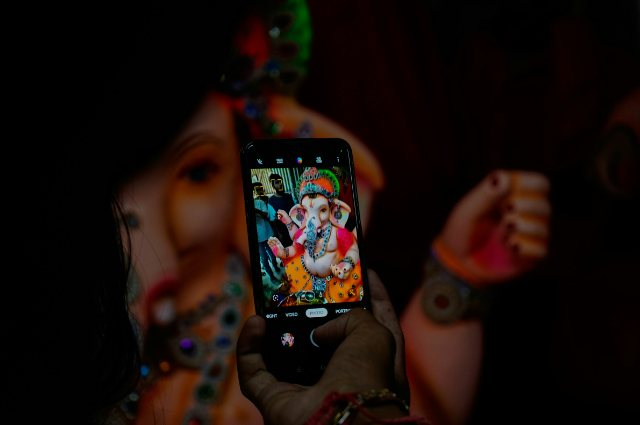
Photo by Kanishk Agarwal on Unsplash
“Share that lamp, not just the hope.”
The process of celebration has always been the process of joining, of spreading diyas, of drawing rangoli, and of enjoying a grand feast with your peeps. However, fast-forward to today and social media is transforming how Indians observe and celebrate their cultural festivals: be it doing virtual aartis to using apps to get food delivered, online rituals to do-it-yourself craft videos. Close or distant, tradition has started doing its thing on a social feed.
A Festival Revolution in Fast-Forward
Nostalgic rituals such as Diwali, Holi, Onam, and Durga Puja have always been heavily rooted within common worship actions and physical associations. However, recently, social media has allowed a humbler shift in the way celebrities are experienced.
Zoom and WhatsApp virtual meetings, which were necessitated during the pandemic, have not gone away. Home-made digital rangoli video tutorials, e-cards, and live stream ceremonies within temples have joined ranks with family pujas and street processions. Tech-induced commerce drives seasonal spending: delivery of food and last-minute online gift purchases.
In the middle of it all, startups and apps present ritual access right to your fingertips- with digital poojas, AI-assisted satsangs, and temple livestreaming to the urban diasporic millennial populations.
From DIY E-Lyrics to Digital Artis
Social platforms and mobile apps have caused a distinction between participation and performance. Instagram and WhatsApp, and others, become means to share e-cards, Diwali aarti videos, and rangoli hacks on platforms like WhatsApp and Instagram during Diwali, but they are online just like everything is during Diwali, except that on your doorstep is the reason homegrown traditions evolve through your feeds.
Onam in Kolkata has been going virtual, with Malayalee groups putting on “chat shows, blog competitions, and performances” via Zoom: a ritual refashioned as people remained physically more connected than ever before but emotionally more isolated.
Digital pioneers such as the color runs and Holi one, where festival performance of color is replicated across continents through Instagram reels and TikTok hashtags, exploit cultural geography in micro-time-bites.
Rituals by Subscription
With 945+ religious technology start-ups and more to come, the spiritual-tech boom has seen poojas, havans, and temple rituals come online with custom A/V interfaces and even delivery of ritual supplies. These are services that satisfy diaspora populations and city-dwelling millennials, who desire ceremonial convenience that is not restricted by a location.
Live-stream occasions are done on apps, Users as OnlinePujaBooking.com, with audio prompts guiding through the process provided by AI used by people in need of a connection, balancing faith and technology.
Festive Commerce 2.0
Festival shopping has turned online. There are e-greeting cards instead of a handwritten note, Q-commerce applications that bring sweets and snacks, and platforms that offer Diwali-related campaigns. Statistics demonstrate that food orders increase significantly when it comes to festival time and during pre-festive moments, social feeds are dominated by festive-oriented digital marketing blitz days.
With the start of government-approved pandemic lockdowns, the transition does not end: mediums of digital instructions might be drab on paper, yet the reach is to millions, and a few clicks provoke numerous orders.
A Collective Digital Marketplace
Users across India are blending the old and the new.
- Young, talented immigrants and diaspora families frequently watch aarti, and then join their family members on other continents in Zoom calls.
- Festival sharing through storytelling reels, demos of live puja, tutorials of electric rangoli, snappy demonstrations of recipes, and outfit of the day posts.
- A trend such as DIY rangoli challenges and festive goods videos is being shared by thousands of users online- the discussions of Diwali 2024 received 17 million engagements and peaked on the day of the festival.
It does not have fans in every human being. In a linking blog post, the argument was crafted that the digital invitations threaten to diminish the conventional character of the good old personal touch: “There is a threat that sending e-cards as opposed to sending sweets removes the warmth”. The worried opponents are that people will push aside the public ceremonies in order to observe the show on a screen privately.
However, generally, the message is understood: the festivals have two levels-kitchen and couch, temple and tablet. The second one is no longer niche.
Harmony Between Pixels and Puja: MESSAGE
The change that takes place demonstrates that Indian festivals are indestructible-they transform, change, and innovate. This is why it is (at least) important:
- The new Tavern is Digital TVs have turned into temples. Aartis live on the internet and recreate the spiritual atmosphere, even when you are far away.
- Tradition Goes Democratic. You can no longer be excluded geographically or physically, from homes of diaspora to isolated tribal villages.
- Growth of economic ecosystems Sugar to shawls, donations to temples, to subscription poojas, all began to scale up the level of festivals with digital tools.
- Risks: Over-commercialization & Disconnection The critics reasonably fear fatigue with festivals, their burnout, and the loss of communal coziness. The problem is where to draw the line between screen time and time in common space.
The sweet spot? Workable rather than replacements, social media is the enabler of the festival.
FINAL THOUGHT
Indian festivals are alive because India can remember them through ritual, rhythm, and unity. Those have not disappeared with social media, but they have recreated a new language.
That is right, so light up that virtual diya, draw a digital rangoli, and share the happiness online. But what you mustn't forget is that even the best parties still occur when displays diminish, and we meet in the flesh.
